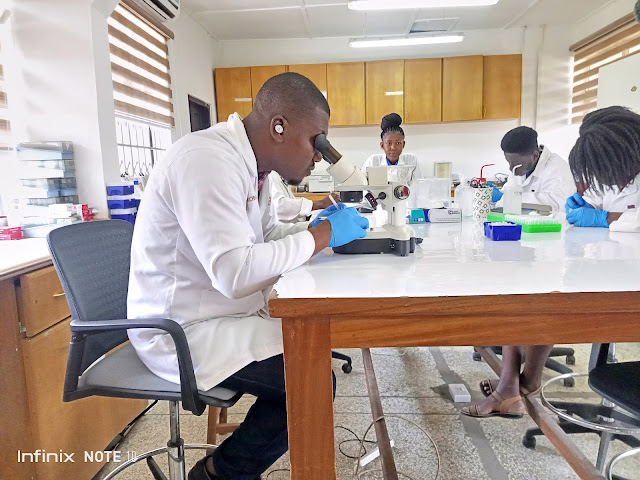SCALE UP ‘INDOOR RESIDUAL SPRAYING’ NATIONWIDE TOWARDS ATTAINMENT OF 2030 MALARIA ELIMINATION TARGET-OBUASI HEALTH OFFICIALS TO GOV'T.
 |
| Mad.Yaa Manu-Obuasi Municipal Director of Health during the interview |
Data obtained from major hospitals sampled and the Municipal Health directorate have showed that, not only has Malaria lost its unenviable long standing record as the number one cause of hospital attendance and admission during the four-year period, but has not led to the death of either an infant or woman.
Health experts in the Municipality are convinced that elimination of the disease by the target date is highly feasible if the ‘Indoor Residual Spraying’ IRS intervention would be scaled up across the country since it is the main factor in the successes achieved in the municipality.
 |
| OPD attendance and hospital admissions due to malaria have dropped significantly |
This means, the few healthcare facilities within the enclave were continually kept under severe pressure with malaria as the main cause of hospital admissions while the main corporate employer in the area, Anglogold Ashanti, bore the brunt of high incidence of absenteeism and low productivity among its workforce.
 |
| Mr. Samuel Asiedu Agyei-Director of AGAMAL |
“The initial objective of this programme
was to reduce malaria incidence by 50% in the first 2 years. But due to the
strategy and other interventions that were put in place, we were able to record
74% reduction in malaria incidence in the first two years. That made it very
successful and then it was recommended to the National Malaria Control
Programme at that time and with the support of the government, we had some
resource from the Global Fund to expand beyond what the mine was doing”,
Mr. Agyei explained.
But over time and based on the huge success rate at the pilot level, with the coming on board of the Global Fund support by Anglogold Ashanti, the Indoor Residual Spraying intervention was scaled up to all communities in the Obuasi enclave.
Ashanti Today therefore went on a mission to ascertain the level of this intervention’s impact in Ghana’s malaria elimination efforts in the next seven years.
 |
| Scientist at work at the AGAMAL laboratory |
At Domeabra, one of the beneficiary communities in the Obuasi East district, a beneficiary landlord, 57-year old Mr. Ahmed Nkrumah, in sharing his experience with the intervention so far narrated what motivated him to embrace the intervention.
“I’d a catastrophic experience
with malaria about 20 years ago when four of my when the Indoor Residual
Spraying had not started when four of my children were all down with malaria.
When they were sent to the AGA Hospital, three of them were admitted while one
was treated and discharged. The doctors were very much annoyed with me that I
was not taking good care of my kids. But, by God’s grace, the 3 who were
admitted were also treated and discharged. And a year later the mine introduced
the IRS and extended to the community. I must say, since that time, as a
family, none of us has gone to the hospital for malaria treatment”, he
noted.
On her part, Mrs. Tabi
Amponsah, amidst giggles said “for about five years now, anytime I attend
hospital, the doctors diagnose and treat me for other ailments but not for
malaria. Apart from addressing malaria, when they spray, insects like cockroaches
and reptiles like wall gecko which are a major bother also vanish.”
With a population of more than 104 thousand and 12 approved public and private healthcare facilities, Ashanti Today then followed up to the two major referral hospitals in the area. These are the AGA Hospital now AGA Health Foundation, and the Obuasi Government Hospital.
 |
| Dr. Kwadwo Anim using graph to demonstrate the downward trend of malaria cases at the AGA Health Foundation(formerly AGA Hospital) |
Referring from his
computer, Dr. Nyarko-Jeckey said “when we look at our four year trend from
2018, malaria complications dropped from top of the list to 3rd instead of the
usual unenviable 1st position and from 2020, malaria dropped to 6th
among the top list of attendance and this position has been maintained and we
believe that it will drop further.”
“In the past few
years, malaria is no more a headache. Out of an attendance of a minimum of 12,
000 and a maximum of 17, 000 in a month, and you’re looking at a maximum of 400
cases of malaria, that is significant”, the AGA Health Foundation Executive Director used a chart to
explain.
The Municipal Director of Health, Mad. Margaret Yaa Manu, disclosed that, since 2018, there has not been any infant or maternal mortality due to malaria within her jurisdiction and attributed the record largely to impact of the Indoor Residual Spraying as an intervention.
Just like the two
medical doctors had said, Mrs. Manu is convinced that elimination of malaria in
Ghana by the 2030 national target is feasible.
“They should scale up the I.R.S.
and at the tail end, we add other interventions to complement it so we can
reach our target. It’s very feasible if we put all hands on deck”, the
Municipal Health Director noted.
Director of AGAMAL, Mr. Samuel Asiedu Agyei, assured that with sustained support of the Global


Comments
Post a Comment